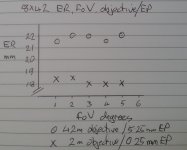With regard to eye relief, not only is there reduced depth of field, but the eye performance is worse in poorer light, both because of a faster f ratio and 'sensor' and processor (brain, eye).
One, I think, has to consider also the size and curvature of the eyeball and cornea and the position of the iris.
With glasses, there is the prescription, usually different for each eye.
The thickness of the glass, the position of the glass, along the axis, up and down, sideways, and tilt.
The refractive index of the glass.
Although, maybe seemingly different, I wondered a few days ago why the aircraft photos I took had such poor resolution.
I was using a compact Canon G15, which I find to be excellent in low light. f/1.8-f/2.8 lens.
The exposures 1/1600 second f/2.8 ISO 80.
Today was clear, but late at 15.15 UT winter day.
G15 12 megapixel? photos 1/2000 second f/2.8 ISO 80 Sky.
28-140 equivalent fl plus 4x digital zoom.
Actual fl 30.5mm plus 4x digital zoom.
Canon A720IS, my normal camera which always takes good aircraft photos.
8 megapixel, even smaller sensor than G15 and older processor. 2007, f/2.8-4.8 lens.
1/640 second f/4.8 ISO 80. Same sky position as photos with G15.
35-210 equivalent fl plus 4x digital zoom.
Actual fl 34.8mm plus 4x digital zoom.
So why are the aircraft photos much poorer in the more modern G15 with later processor.
I think that it is because the lens is optimsed for low light and at f/2.8 is much faster than the more modest f/4.8 of the older Canon A720.
For aircraft, one can read birds, as the Canon A720 IS takes excellent photos of flying birds.
Both cameras have optical viewfinders with good centration, so even with 4x digital zoom the birds are well in frame using the optical viewfinder.
The difference to me is surprising and I think that the whole optical system has to be considered regarding binoculars and the eye regarding eye relief in good and poor light.






